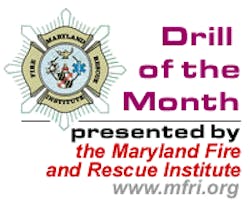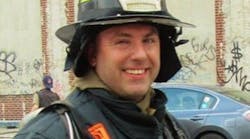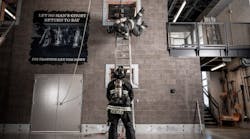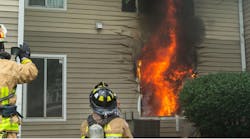Coordinated Fire Attack
Time Required: Two Hours
Materials:
· Transparencies (To be created by user)
· Overhead Projector
· Screen
References:
· Engine Company Fireground Operations, Second Edition, Harold Richman, NFPA
· Truck Company Fireground Operations, Second Edition, Harold Richman, NFPA
· Essentials of Fire Fighting, Fourth Edition, IFSTA
PREPARATION:
Motivation:
Objective (SPO): 1-1
The firefighter will demonstrate a working knowledge of the importance of a coordinated fire attack and the various activities that can take place simultaneously as part of that coordinated attack, from memory, without assistance, to a written test accuracy of 70%.
Overview:
· Coordinated Fire Attack
· Overview of Fire Attack
· Rescue Activities
· Exposure Protection Activities
· Fire Confinement Activities
· Fire Extinguishment Activities
· Overhaul Activities
· Ventilation Activities
· Property Conservation Activities
· Coordinated Fire Attack
Coordinated Fire Attack
SPO 1-1 The firefighter will demonstrate a working knowledge of the importance of a coordinated fire attack and the various activities that can take place simultaneously as part of that coordinated attack, from memory, without assistance, to a written test accuracy of 70%.
EO 1-1 Describe the basic fireground objectives.
EO 1-2 Describe how rescue activities are supported during fire attack.
EO 1-3 Describe how exposure protection activities are supported during fire attack.
EO 1-4 Describe how fire confinement activities are supported during fire attack.
EO 1-5 Describe how fire extinguishment activities are conducted as part of the fire attack.
EO 1-6 Describe how overhaul activities are conducted as part of fire attack.
EO 1-7 Describe how ventilation activities are conducted in support of fire attack.
EO 1-8 Describe how property conservation activities are conducted in conjunction with fire attack.
EO 1-9 Describe the simultaneous activities that take place as part of a coordinated fire attack.
This drill is intended to be conducted as an interactive discussion with everyone encouraged to participate. the discussion also provides an opportunity to think about other actions that may need to take place or are taking place on the scene that may affect what they are doing. Coordination of various fireground activities will provide a safer work environment for firefighters and reduce potential harm to victims.
I. Overview of Fire Attack (1-1)
A. Fireground objectives must be considered in a specific sequence
1. Rescue
2. Protect Exposures
3. Confine the Fire
4. Extinguish the Fire
5. Overhaul
6. Ventilation and property conservation must be considered as part of any other activity
B. While all objectives may not be required at every incident, they should be considered
C. Various objectives can take place at the same time
D. Objectives may be carried out by different companies since one company cannot be expected to be responsible for every activity
II. Rescue Activities (1-2)
A. Immediate rescue without coordinated fire attack should be attempted only in extreme cases
B. Engine companies can aid rescue by placing protective streams between victims and fire
C. Water essential to search and rescue operations
1. Separate fire from people closest to it
2. Control interior stairways and corridors for evacuating occupants and advancing firefighters
3. Protect firefighters searching above and around fire
D. Primary function during rescue is to contain fire and keep it from jeopardizing anyone in fire building
III. Exposure Protection Activities (1-3)
A. Fire travel affects possible exposures and can cause fire to extend to other areas
1. Convection - travel of heat through motion of heated matter
a. Smoke
b. Hot air
c. Heated gases
d. Flying embers
e. Fire travel by convection presents greatest fire fighting problem
f. Smoke moves vertically and horizontally - mushrooming
g. A separate fire may ignite from hot air and combustion products rising
2. Radiation - travel of heat through space (electromagnetic waves)
a. Unaffected by wind
b. Radiated evenly in all directions
c. Will pass through water; stream must be directed on surface
d. Travel blocked by solid surfaces
e. Can pass through glass
3. Conduction - travel of heat though a solid body
a. Through walls and floors by way of pipes, metal girders and joists
b. May cause steel building and roof supports to collapse
B. Second only to rescue on list of basic objectives
C. Structures near fire building (exterior exposures) and parts of fire building not involved (interior exposures)
D. Exposure coverage
1. Structure or materials closest to fire covered first
2. When exposures fairly close, most vulnerable areas just above fire
E. Interior exposures
1. Fire in concealed spaces, especially walls, ceilings, and floors
2. Vertical fire spread
3. Horizontal fire spread
4. Open interior spread
F. Exterior exposures
1. Spacing between fire and exposure
2. Building construction and materials
3. Intensity and size of fire
4. Location of fire
IV. Fire Confinement Activities (1-4)
A. Determine fuel load to establish water supply
1. Consists of interior surfaces, furnishings, and contents for interior fires
2. Exterior surfaces when fire has extended
3. Factors affecting fuel loading
a. Type of fuel involved
b. Quantity of fuel
c. Arrangement of fuel
B. Establish water supply to support flow requirements
1. Hose lays can be accomplished with either single or multiple lines, dependent upon
a. Flow requirements
b. Length of lay
c. Size of hose
C. Select adequate size hose and proper size nozzles to confine and extinguish the fire
1. Engine company must consider limitations of various sizes of hose
2. Flow limitations of hose (based on 1,000 feet)
2-1/2-inch 250 gpm
3-inch 400 gpm
4-inch 800 gpm
5-inch 1,500 gpm
3. Range of nozzle flows for combination nozzles with recommended nozzle pressure of 100 psi
1-1/2-inch 30 gpm to 125 gpm
1-3/4-inch/2-inch 95 gpm to 200 gpm
2-1/2-inch 125 gpm to 250 gpm
4. Flows for a 2-1/2-inch straight tip nozzle with recommended nozzle pressure of 50 psi
1-inch tip 210 gpm
1-1/8-inch tip 266 gpm
1-1/4-inch tip 328 gpm
5. Flows from master stream devices
a. Fog nozzle minimum is 500 gpm at 100 psi nozzle pressure
b. Flows for straight tips with recommended nozzle pressure of 80 psi (rounded)
1-1/2-inch 600 gpm
1-5/8-inch 700 gpm
1-3/4-inch 800 gpm
1-7/8-inch 900 gpm
2-inch 1000 gpm
6. It is better to have excess flow capability and extinguish the fire quicker than to have inadequate
flow and loss the structure
D. Basement fires
1. Use all openings as points of attack
2. Requires full ventilation of basement and first floor
3. Stairways and other openings major channels for vertical spread
Note: Coordination during the confinement and extinguishment phases of fire attack is very important to avoid injury to firefighters. Opposing attack lines can push heat and fire to other firefighters and possibly cause a flashover due to heat buildup.
V. Fire Extinguishment Activities (1-5)
A. Effective stream operation
1. For safest and most effective operation where people in area, solid stream or fog nozzle on solid
stream position should be used to aid rescue and reduce steam production
2. Stay low upon entering fire area to let heat and gases vent before moving in
3. Before opening door to fire area, all firefighters should be positioned on same side of entrance and
remain low
4. Crack nozzle and bleed air out of line ahead of water
5. If fire shows at top of door as opened, ceiling should be hit with solid stream to cool and control
fire gases
6. Sweep floor with stream to cool burning debris and hot surfaces
7. Do not open stream until fire can be hit unless firefighter safety is affected
8. Direct stream at base of fire if localized
9. As advance made, angle of stream should be lowered and attempt made to hit main body of fire
10. When main body of fire knocked down, shut down stream and let area to vent
11. When fire knocked down, shut down
12. Upon entering an area, which is very, hot and finding no fire, withdraw immediately and check
area below
13. When attacking basement fire down interior stairs, solid stream should be used because fog will
generate steam
14. Use of fog should be restricted to unoccupied confined spaces
15. When building adequately ventilated opposite direction from fog nozzle, fog stream can be used
a. No more than 30-degree angle
b. Produces reach and fog pattern
16. If large intense fire encountered, may be necessary to knock down or control fire from outside
using solid stream before making interior attack
15. When building adequately ventilated opposite direction from fog nozzle, fog stream can be used
a. No more than 30-degree angle
b. Produces reach and fog pattern
16. If large intense fire encountered, may be necessary to knock down or control fire from outside
using solid stream before making interior attack
C. Where to look
1. Walls and ceilings
2. Above fire
3. Shafts
4. Cabinets and compartments
5. Window and door facings
VII.Ventilation Activities (1-7)
A. Review latent heat of vaporization to establish the need to ventilate steam
1. Water boils at 212oF
2. When raising the temperature of water from 60oF to 212oF, one BTU of heat is absorbed for
each degree of heat increase - 152oF increase equals 152 BTU's
3. When water is converted from liquid to steam, it absorbs 970 BTU's. This is seven times greater
than going from 60oF to 212oF
4. One cubic foot of water expands to 1700 cubic feet of steam
B. Ventilation is the process of making openings in building or exposure to allow heat and products of combustion to leave building
C. Ventilation contributes directly to accomplishment of basic fire fighting objectives by
1. Reducing danger to trapped occupants and extends time for rescue operations
2. Increasing visibility thereby decreasing danger inherent in other fireground operations and increasing
efficiency
3. Permitting quicker and easier entry to allow search operations or to advance lines
4. Minimizing time required to locate seat of fire
5. Minimizing time required to find areas to which fire has spread
6. Decreasing or stopping spread of fire
7. Reducing chance of flashover or backdraft
D. Results depend on size and type of occupancy involved, extent and location of fire, and whether fire is free burning or smoldering
E. When properly performed, ventilation increases effectiveness of most operations
F. Ventilation aids in saving lives
G. General rule is open fire building so that all accumulations of heat and combustion products leave building by natural convection
H. Windows can be opened as the initial means of ventilation - they should not be broken out if possible
I. Mechanical devices such as smoke ejectors and positive pressure blowers cannot be used as a substitute for natural venting techniques
J. Mechanical devices should not be used in partially or completely confined spaces in which there is fire
K. Positive pressure ventilation has potential of moving fire and fire gases
L. Positive pressure ventilation is only effective on structures when doors and windows maintained
M. Fog streams can be used to start venting immediately after fire has been knocked down
VIII. Salvage Activities (1-8)
A. Water to attack the fire can cause unnecessary damage due to excessive water application
B. Unnecessary entry can cause unnecessary damage
C. Prompt removal of smoke, heat, and water contributes to damage reduction
D. Salvage or property conservation is reducing the damage not directly related to the fire
E. Salvage is not just the placement of covers or the removal of water and smoke but the use of common sense throughout the operation
IX. Coordinated Fire Attack (1-9)
A. Staffing single most important part of engine company
1. 29 CFR 1910.134(e) (OSHA Regulation) (Two-in/two-out rule)
a. At least two firefighters enter the IDLH atmosphere and remain in visual or voice contact with
one another at all times
b. At least two other firefighters are located outside the IDLH atmosphere to be able to assist
personnel in case of emergency
c. Lack of additional personnel is not meant to preclude firefighters from performing emergency
rescue activities before an entire team has assembled
2. Failure to consider safety could be negligent on part of leadership of department
B. Size-up is defined as the sequence of thoughts and mental activity carried out by the individual-incharge
1. Begins upon receipt of alarm and continues until the operation is successfully concluded
2. Process may be carried out many times and by many different individuals during fire
3. Responsibility initially lies with individual-incharge of first company on scene
4. As other units arrive with persons of higher rank or jurisdiction, responsibility is passed up chain of
command
5. Proper size-up will result in the safe, timely, and efficient control of an emergency situation
6. Care must be exercised to insure that the total problem is evaluated
7. Size-up must be a dynamic process, continuing throughout all phases of the operation.
C. Officer in charge of first arriving apparatus must first consider the rescue problem and determine if such a condition exists
1. Should conditions indicate potential rescue situation, any activities undertaken should be directed
toward relieving the rescue problems
2. This entails number of considerations
a. All resources and activities should be directed toward accomplishing the actual rescue problem
b. Nothing done by way of an attack effort should interfere with or restrict rescue operations
c. Allocation of tools and equipment should favor those involved in the rescue effort
d. Ventilation, point of entry, and the placement of hose lines should be aimed toward protecting
those in immediate danger and the crews involved in the rescue effort
3. Possible that hose lines will be used to support rescue with no attempt to extinguish or even confine
fire
4. Time is critical, each minute of continued exposure of victim reduces chances for safe rescue
5. Life safety is first and primary consideration in all fireground activities
D. Once necessary details of rescue have been considered, or when no rescue problem exists, officer in charge should next direct thoughts and efforts toward confining fire to as small an area as possible
1. First concern must be for the adjacent exposures to which fire can spread
2. Attack must be toward cutting off route of fire travel to uninvolved exposures
3. If first effort isn't put toward checking fire spread, and is applied to the heart of the fire, neglected
edges of fire may spread to involved more areas and materials and result in fire of much greater
magnitude than first faced
4. First route of extension of fire will be in an upward direction (vertical)
a. If upward extension is prevented by lack of fuel, natural barriers, or other reasons, it will then
attempt to spread outward (horizontally)
b. If both of the preceding avenues are restricted, the fire will spread downward
c. Working knowledge of building construction features is also advantageous in projecting the
extension of fire
5. Fire will continue to burn unchecked unless
a. All fuel is consumed
b. Oxygen supply is depleted
c. Rate of heat released is reduced to a point where the process is no longer sustained
E. Size-up for extinguishment must consider
1. Nature of fuel involved
2. Quantity of fuel involved - provide an indication as to quantity of extinguishing agent required
3. Physical arrangement of fuel involved – will assist in determining method of application utilized
a. Anticipated rate of release of heat can be established
b. Surface to mass ratio or the surface available characteristics of the fuel
c. Will determine how rapidly heat released and degree of difficulty in extinguishing fire.
As a follow-up to this drill, the department may want to conduct a live firefighting exercise to demonstrate the benefits of a coordinated fire attack.
SUMMARY:
Review:
· Coordinated Fire Attack
· Overview of Fire Attack
· Rescue Activities
· Exposure Protection Activities
· Fire Confinement Activities
· Fire Extinguishment Activities
· Overhaul Activities
· Ventilation Activities
· Salvage Activities
· Coordinated Fire Attack
Remotivation:
A coordinated fire attack is important to the success of the overall fireground operation. It is not enough to focus on attacking the fire without consideration the impact on other firefighters and victims by failing to protect exposures and confine the fire while ventilating throughout the operation.






